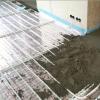Welding sheet polypropylene with a hair dryer.
Technology of welding sheet polypropylene with a hair dryer.
Welding polypropylene sheets with a hair dryer is the connection of the edges of two polypropylene sheets using a building hair dryer (air gun. The device heats the joined edges of the sheets and the polypropylene wire located between them to 270 ° C, fusing all three elements with each other.
Stages of welding polypropylene sheets with a hairdryer:
The choice of material. You need a building hair dryer of sufficient power, thin polymer sheets and a polypropylene rod (wire. The rod and sheets must be made of the same class of material, otherwise they will melt unevenly under the influence of hot air.
Docking. Sheets are placed on any flat surface, their edges are processed with sandpaper. The fusion process itself is similar to welding using a fusible electrode. That is, the welder moves the hair dryer along the seam, filling the joint with meltable polypropylene, which is the welding rod. After 5-7 minutes, the welded sheets can be used for their intended purpose.

Important! When welding with a hair dryer, be aware that when fusing slowly, the areas of the polymer sheet immediately adjacent to the weld area can become very hot. This will distort the seam. Therefore, when using a hair dryer, welding should be done quickly.
Advantages and disadvantages of welding with a hair dryer.

The seam created by this method has the lowest strength than the seams created using other welding technologies. The maximum strength factor with such fusion does not reach a value greater than 0.7. Therefore, parts with not very thick edges are usually fastened using this method - no more than 6 mm. However, for fast fusing of small thin parts, this method is the best solution.
Welding of sheet polypropylene with an extruder.
Welding polypropylene sheets with an extruder is a reliable way to join polypropylene sheets used for the manufacture of various containers, electroplating baths, air ducts, septic tanks and other bulk structures.
Extruder sheet welding technology:
Materials and devices. For work you will need: polypropylene sheets, a polypropylene rod or an electrode and a manual extruder. The rod and sheets must be made of the same grade of polymer, otherwise they will melt unevenly.
Docking. Sheets ends close to each other lie on any flat surface. Between them, in the seam zone, a polypropylene rod is clamped. Further, with the help of an extruder, the bar and edges are heated and fused.
The extruder operates at a temperature of 270? C. welding work must be carried out promptly. Otherwise, the areas of polypropylene sheets adjacent to the seam will be deformed, the seam will come out fragile.
Advantages and disadvantages of extruder welding.
The seam made with the use of an extruder is stronger than the joints made with a hot air gun. Its strength factor is up to 0.8. With the help of an extruder, sheets of polypropylene up to 16 mm thick can be quickly and firmly connected directly at the workplace.
Gluing polypropylene - how to glue polypropylene.
Polypropylene is a hard-to-glue type of plastic - it is extremely difficult to glue it without welding. In addition, this process requires mandatory preparation.
You can use special adhesives that quickly and quite qualitatively glue the plastic. The main thing in this matter is to choose a good solution.
Types of glue for polypropylene.
Plastic adhesives fall into several categories:
Thermosetting. They are based on polyester, epoxy and other thermosetting resins.
Thermoplastic. This category can be schematically divided into two areas: resin-based and rubber-based thermoplastic compounds.
Thermoplastic adhesive formulations dissolve and soften under the influence of temperature. Unlike thermosets, they do not change their chemical structure when glued, which is their advantage.
Also, adhesive compositions are divided by the number of components: into one - and two-component. The first are sold in one copy in a ready-made form and in a single package. The second have two packages of components. Before starting work, both components must be mixed, strictly following the manufacturer's instructions.
An example of a one-component adhesive is the instant "Cosmoplast 500", designed for gluing profiles in window production. An example of a two-component solution is an epoxy adhesive for plastics. Its components are epoxy resin and hardener.
Two-component adhesives have the advantage of a longer shelf life than one-component adhesives. The reason is that until their components come into contact, curing will not occur.
Gluing preparation process.
Before gluing polypropylene parts, preparation is necessary. It consists in checking everything necessary and assembling the general structure without the presence of glue in order to put marks in places where it is needed.
An example of preparation for gluing polypropylene pipes:
It is necessary to make sure that the air temperature of the room where the bonding will take place is between 5\xB0s - 35\xB0s.
It is important to check the availability of tools. A glue gun, pipe cutters and a natural bristle brush should be on hand.
Scissors (pipe cutters) need to cut the pipes into segments of a certain length.
Next, it is desirable to clean the edges of the cuts using sandpaper. Remove any burrs that may prevent the joint from sealing.
Now it is necessary to assemble the entire structure, try on and make marks with a marker in the places of future gluing, as well as marks the depth of entry into the pipe fittings. After that, you can disassemble the structure.
Before application, the adhesive must be mixed well. Marked areas must be degreased and cleaned with cleaners.
Important tips.
For installation, it is better to choose a proven brand, and not start from the cost of glue. Expensive solutions are sometimes inferior in quality to solutions with an average price.

